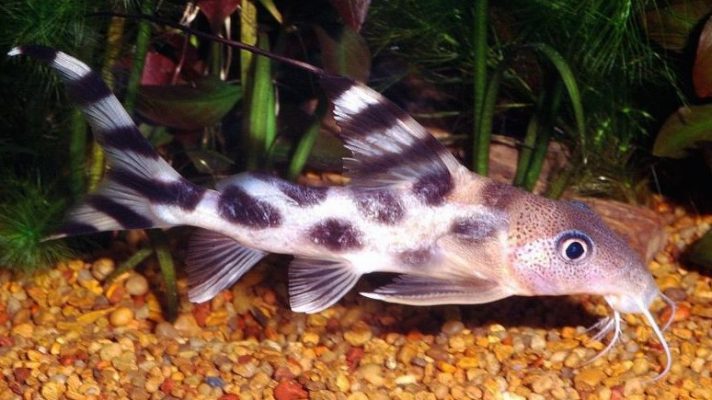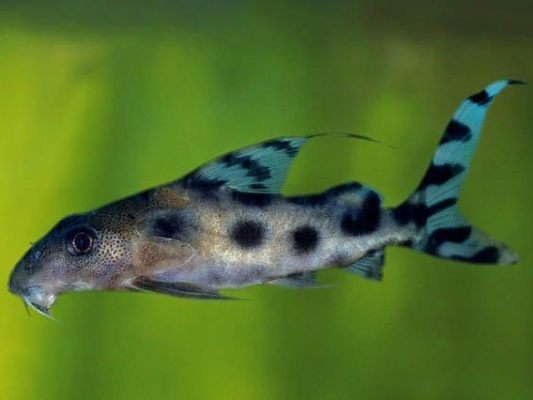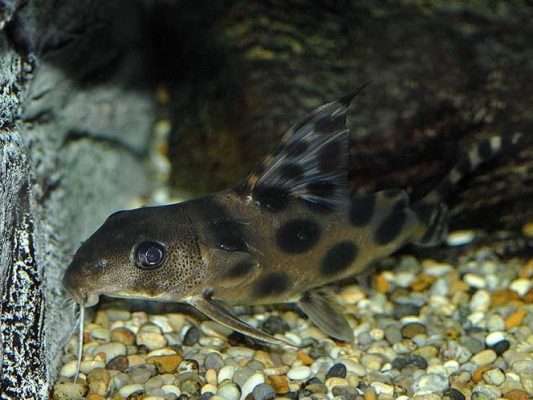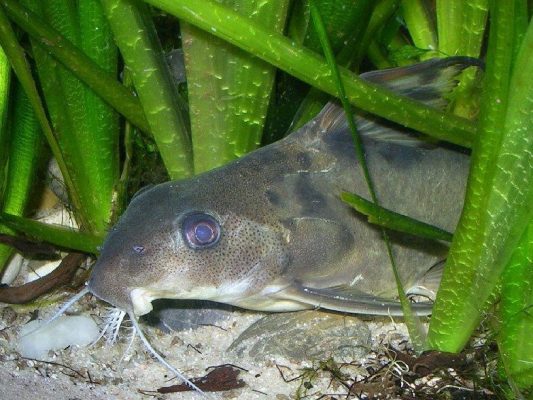Decorated Squeaker

Table of Contents
- Introduction
- Physical Characteristics
- Habitat and Distribution
- Behavior and Social Structure
- Reproduction and Life Cycle
- Conclusion
Introduction
The Decorated Squeaker, scientifically known as Synodontis decorus, is a fascinating and unique fish species that has captured the attention of aquarium hobbyists worldwide. With its distinctive characteristics and undeniable appeal, this species has become highly sought after in the aquarium trade.
The Decorated Squeaker is known for its striking appearance, which sets it apart from other fish species. It possesses a sleek body shape, adorned with vibrant colors and intricate patterns. Its fins are beautifully elongated, adding to its overall elegance. The mouth structure of the Decorated Squeaker is also worth noting, as it is perfectly adapted for its feeding habits and survival in its natural habitat.
Studying the Decorated Squeaker is of great significance for both scientific and conservation purposes. By delving into the intricacies of this species, researchers can gain valuable insights into the functioning of aquatic ecosystems and the overall biodiversity of our planet.
Understanding the behavior of the Decorated Squeaker is crucial for comprehending its role within its habitat. By observing its interactions with other species and its preferred habitat requirements, scientists can gain a better understanding of the delicate balance that exists in aquatic environments. This knowledge can then be applied to the conservation and management of other species and their habitats.
Furthermore, studying the Decorated Squeaker can shed light on its reproductive strategies and life cycle. By unraveling the mysteries of its breeding behavior and parental care, scientists can contribute to the broader understanding of fish reproduction and development.
In this article, we will delve into the physical characteristics of the Decorated Squeaker, examining its unique appearance and adaptations that aid in its survival. We will also explore its habitat preferences and distribution, shedding light on the specific environmental conditions required for its survival. Furthermore, we will analyze its behavior and social structure, providing insights into its feeding habits, social interactions, and defense mechanisms. Additionally, we will delve into its reproductive strategies and life cycle, uncovering the fascinating journey from mating to adulthood. Lastly, we will discuss the threats faced by the Decorated Squeaker and the conservation efforts in place to protect this remarkable species.
Physical Characteristics
Description of the Decorated Squeaker’s Appearance
The Decorated Squeaker (Synodontis decorus) is a visually striking fish species that captivates fish enthusiasts with its unique physical features. Belonging to the family Mochokidae, it is native to the rivers and streams of Central Africa.
The Decorated Squeaker has a distinct body shape characterized by a streamlined and elongated form. Its body is covered in smooth, scaleless skin, giving it a sleek and elegant appearance. Typically, this species reaches a length of around 8-12 inches (20-30 cm), making it one of the larger species in the Synodontis genus.
One of the most notable features of the Decorated Squeaker is its impressive array of fins. It has a large dorsal fin that runs along its back, starting from the head and extending towards the tail. This fin is adorned with a striking pattern of black and white spots or stripes, adding to its visual appeal. The pectoral and pelvic fins are also well-developed, allowing the fish to maneuver gracefully in the water.
The mouth structure of the Decorated Squeaker is another fascinating aspect of its physical characteristics. It has a downward-facing mouth with several rows of small, sharp teeth. This mouth structure is well-suited for its omnivorous diet, which includes both plant matter and small invertebrates.
Examination of Size, Coloration, and Unique Markings
The Decorated Squeaker exhibits a range of coloration and markings that vary based on age and habitat. Juvenile individuals often display a vibrant yellow or orange coloration, which gradually transitions to a darker shade as they mature. The body coloration can range from shades of brown to gray, providing effective camouflage in its natural environment.
One of the most striking features of the Decorated Squeaker’s coloration is the presence of intricate patterns, spots, and stripes. These markings are unique to each individual and serve multiple purposes. They aid in camouflage, allowing the fish to blend seamlessly with its surroundings, making it less visible to predators or potential prey. Additionally, these markings may play a role in communication and species recognition among conspecifics.
Discussion on Adaptations that Aid in Survival
The Decorated Squeaker possesses several adaptations that contribute to its survival in its natural habitat. One notable adaptation is its ability to breathe air. This species possesses a specialized structure called a labyrinth organ, located in its gills, which allows it to extract oxygen from the air. This adaptation is particularly advantageous in oxygen-deprived or stagnant water conditions, ensuring the fish’s survival even in challenging environments.
In addition to its respiratory adaptation, the Decorated Squeaker has well-developed sensory organs that aid in its survival. It has a highly sensitive lateral line system, which allows it to detect subtle water movements and vibrations. This sensory adaptation helps the fish navigate its surroundings, locate prey, and avoid potential threats.
Furthermore, the Decorated Squeaker has a unique adaptation in its mouth structure. The presence of multiple rows of small, sharp teeth enables it to efficiently consume a wide range of food sources, including plant matter and small invertebrates. This adaptability in diet contributes to its success in finding sustenance in diverse aquatic ecosystems.
Overall, the Decorated Squeaker’s physical characteristics, including its streamlined body shape, striking coloration, and specialized adaptations, make it a truly remarkable species in the aquarium hobby. Understanding these physical attributes not only enhances our appreciation for its beauty but also sheds light on its survival strategies in the wild.
Habitat and Distribution
Overview of the natural habitat of the Decorated Squeaker
The Decorated Squeaker, also known as Synodontis decorus, primarily inhabits freshwater habitats, specifically rivers, streams, and lakes. This species is native to the African continent, with its natural range extending across several countries, including Cameroon, Nigeria, and the Democratic Republic of Congo.
In terms of habitat preferences, the Decorated Squeaker exhibits a preference for areas with slow-moving or still water. It is commonly found in areas with dense vegetation, such as submerged plants, floating plants, and overhanging branches. These habitats provide the fish with shelter, protection, and a source of food.
Exploration of the geographical distribution of the species
The Decorated Squeaker has a relatively wide distribution across various regions in Africa. It can be found in the Niger River basin, the Chad Basin, and the Congo River basin. Within these regions, the species may have variations or subspecies that have adapted to different environmental conditions.
For example, in the Niger River basin, the Decorated Squeaker has been observed in the Niger and Benue rivers, as well as their tributaries. In the Congo River basin, it can be found in the Congo River itself, as well as in the Kasai and Ubangi rivers. These variations in distribution highlight the species’ ability to adapt to different habitats within its range.
Discussion on the preferred environmental conditions and habitat requirements
The Decorated Squeaker has specific environmental requirements for its survival. It thrives in water temperatures ranging from 22 to 26 degrees Celsius (72 to 79 degrees Fahrenheit). The pH levels of its habitat should be slightly acidic to neutral, typically ranging from 6.0 to 7.5. It is important to note that extreme fluctuations in temperature or pH levels can be detrimental to the species.
Additionally, the presence of vegetation is crucial for the Decorated Squeaker. The fish relies on vegetation for shelter, spawning sites, and as a source of food. The dense vegetation provides hiding places from predators and creates a suitable environment for the fish to exhibit natural behaviors.
However, habitat degradation and alteration pose significant threats to the Decorated Squeaker population. Deforestation, pollution, and the introduction of invasive species can disrupt the delicate balance of its habitat. These changes can lead to a decline in food availability, water quality, and suitable spawning sites, ultimately impacting the population size and distribution of the species.
In conclusion, the Decorated Squeaker is a freshwater fish species that prefers slow-moving or still water habitats with dense vegetation. Its natural range spans across various regions in Africa, and it exhibits specific environmental requirements for its survival. Understanding and protecting its habitat is crucial for the conservation of this unique species.
Behavior and Social Structure
Examination of the Decorated Squeaker’s behavior patterns
The Decorated Squeaker (Synodontis decorus) exhibits fascinating behavior patterns that make it a captivating species to observe in both the wild and aquarium settings. These fish are known for their active and inquisitive nature, constantly exploring their surroundings and interacting with their environment.
In terms of activity patterns, the Decorated Squeaker is primarily nocturnal, meaning it is most active during the night. This behavior is believed to have evolved as a strategy for avoiding predators and maximizing feeding opportunities. During the day, they tend to hide in crevices or under vegetation, using their excellent camouflage to blend in with their surroundings.
Analysis of its feeding habits and diet
The Decorated Squeaker is an omnivorous species with a diverse diet. In its natural habitat, it feeds on a variety of food sources, including small invertebrates, insect larvae, crustaceans, and plant matter. This adaptability in diet allows the Decorated Squeaker to thrive in different aquatic environments, as it can take advantage of available food sources.
In aquarium settings, it is essential to provide a balanced diet that replicates their natural feeding habits. Commercially available sinking pellets, flakes, and frozen foods can be offered to meet their nutritional requirements. It is also beneficial to supplement their diet with live or frozen foods, such as bloodworms or brine shrimp, to provide enrichment and mimic their natural feeding behaviors.
Discussion on its social structure and interaction with conspecifics
The Decorated Squeaker is a social species that exhibits interesting social behaviors and interactions with conspecifics. They are known to form small groups or pairs, and they are generally peaceful towards other fish species. However, it is important to consider their compatibility with tankmates, as some aggressive or territorial species may cause stress or harm to the Decorated Squeaker.
Within their social groups, Decorated Squeakers engage in various behaviors that contribute to their social structure. They establish hierarchies and maintain a pecking order, with dominant individuals exhibiting more assertive behaviors. These behaviors can include fin flaring, chasing, or nudging other group members.
Exploration of its territoriality and defense mechanisms
Territorial behavior is commonly observed in the Decorated Squeaker, particularly during the breeding season or when defending their preferred hiding spots. They mark their territories using scent cues and visual displays, such as erecting their dorsal fins or flaring their gill covers. These territorial displays serve as warnings to other fish and help establish boundaries within their habitat.
When faced with potential threats or predators, the Decorated Squeaker has developed several defense mechanisms to ensure its survival. One notable adaptation is the presence of sharp spines on their pectoral and dorsal fins, which they can erect when feeling threatened. These spines act as a deterrent to potential predators, making it difficult for them to swallow the fish or causing injury if they attempt to do so.
Additionally, the Decorated Squeaker has the ability to produce audible sounds by grinding their pharyngeal teeth together. This behavior is believed to serve as a warning signal or a means of communication with conspecifics. These unique defense mechanisms highlight the species’ adaptability and resourcefulness in their natural habitat.
In conclusion, the Decorated Squeaker exhibits intriguing behavior patterns, feeding habits, and defense mechanisms that contribute to its overall survival and social dynamics. Understanding these aspects not only enhances our appreciation for this species but also provides valuable insights into its care and conservation in both natural and aquarium environments.
Reproduction and Life Cycle
Overview of the reproductive strategies of the Decorated Squeaker
The Decorated Squeaker, like many fish species, employs various reproductive strategies to ensure the continuation of its population. Understanding these strategies is crucial for gaining insights into their breeding behavior and courtship rituals.
1. The Reproductive Cycle
The reproductive cycle of the Decorated Squeaker begins with the onset of the breeding season, which is typically triggered by environmental cues such as changes in water temperature, photoperiod, or availability of food. During this time, both males and females undergo physiological changes that prepare them for breeding.
2. Breeding Behavior and Courtship Rituals
The breeding behavior of the Decorated Squeaker is characterized by a series of intricate rituals and displays. These behaviors serve to attract mates and ensure successful reproduction.
Male Decorated Squeakers often engage in elaborate courtship displays to attract females. These displays may include fin flaring, body jerking, and vibrant coloration. Visual cues play a significant role in attracting potential mates, as females are often attracted to males with brighter and more vibrant colors.
In addition to visual displays, the Decorated Squeaker also relies on acoustic communication during courtship. Males produce low-frequency sounds, known as “croaking,” by contracting muscles attached to their swim bladder. These croaking sounds are believed to play a role in attracting females and establishing dominance among competing males.
Pheromones also play a crucial role in the courtship process of the Decorated Squeaker. Chemical signals released by males can attract females and indicate their readiness to breed. These pheromones are detected by specialized sensory organs called olfactory receptors, allowing females to locate potential mates.
3. Spawning Process and Parental Care
Once courtship is successful, the Decorated Squeaker engages in the spawning process. Females typically deposit their eggs onto a suitable substrate, such as rocks, plants, or submerged logs. The adhesive eggs are then fertilized externally by the males, who release their milt over the eggs.
After fertilization, both males and females exhibit varying levels of parental care. Male Decorated Squeakers are known for their active involvement in guarding and protecting the eggs. They fan the eggs with their pectoral fins to ensure proper oxygenation and remove any debris that may settle on them.
Female Decorated Squeakers, on the other hand, may continue to provide some level of care by actively defending the nest and assisting the male in egg protection. This shared parental care helps increase the survival rate of the eggs and ensures their successful development.
4. Life Cycle Stages and Growth Patterns
The life cycle of the Decorated Squeaker encompasses several distinct stages, each marked by significant developmental milestones. From hatching to adulthood, the growth patterns and size variations of the Decorated Squeaker provide valuable insights into its life history.
The initial stage of the life cycle begins with the hatching of the eggs. The larvae, known as fry, are initially small and vulnerable. They rely on their yolk sac for nourishment until they can feed independently.
As the fry grow, they undergo a rapid growth phase. During this period, they develop their characteristic coloration and markings. The growth rate of the Decorated Squeaker varies depending on factors such as food availability, water quality, and environmental conditions.
As the Decorated Squeaker continues to mature, it reaches sexual maturity, typically around 1 to 2 years of age. At this stage, the fish is capable of reproducing and contributing to the population’s growth.
Throughout its life cycle, the Decorated Squeaker may exhibit variations in size and growth patterns influenced by genetic factors and environmental conditions. These variations contribute to the overall diversity within the species and highlight the adaptability of the Decorated Squeaker to different habitats.
In conclusion, the reproductive strategies and life cycle of the Decorated Squeaker are fascinating aspects of this unique fish species. By understanding the intricacies of their breeding behavior, courtship rituals, spawning process, and growth patterns, we can gain valuable insights into their biology and contribute to their conservation. Further research and conservation efforts are essential to ensure the survival of this remarkable species and maintain the delicate balance of aquatic ecosystems.
Conclusion
In conclusion, this article provides a comprehensive exploration of the Decorated Squeaker (Synodontis decorus), covering its physical characteristics, habitat, behavior, reproduction, and conservation status.
The Decorated Squeaker is a unique and fascinating fish species in the aquarium hobby. Its distinctive characteristics, such as its large body size, unique markings, and adaptations for survival, make it highly appealing to fish enthusiasts. The popularity and demand for this species among aquarium hobbyists highlight its significance in the aquarium trade.
Studying and understanding the Decorated Squeaker is crucial for scientific and conservation purposes. By studying this species, scientists can gain insights into aquatic ecosystems and biodiversity. Understanding its behavior, habitat requirements, and conservation status is essential for effective conservation efforts.
The physical characteristics of the Decorated Squeaker are remarkable. It has a distinct body shape, fins, and mouth structure. These adaptations aid in its survival, allowing it to thrive in its natural habitat.
Size, coloration, and unique markings play a significant role in the Decorated Squeaker’s appearance. The species exhibits variations in body size based on age and habitat. The range of coloration observed in different individuals, including patterns, spots, and stripes, serves purposes such as camouflage, communication, or species recognition.
The Decorated Squeaker’s habitat and distribution are closely tied to its survival. It prefers rivers, streams, or lakes with specific environmental conditions, including water temperature, pH levels, and vegetation. Understanding its preferred environmental conditions and habitat requirements is crucial for conservation efforts. Habitat degradation or alteration can have a significant impact on the population of this species.
The behavior and social structure of the Decorated Squeaker are intriguing. It exhibits general behavior and activity patterns, with specific behaviors observed in the wild or aquarium settings. Its feeding habits and diet are also important factors to consider, as they contribute to its overall health and well-being. The species is social and can coexist with other fish species, displaying notable behaviors or interactions in groups or pairs. Territoriality and defense mechanisms are also part of its behavior, aiding in survival and avoiding predators.
Reproduction and the life cycle of the Decorated Squeaker are fascinating topics. The species employs specific reproductive strategies, triggered by various factors. Breeding behavior and courtship rituals involve visual cues, sounds, or pheromones to attract mates. Spawning and parental care are essential aspects of its reproductive process. Understanding the life cycle stages, growth patterns, and developmental milestones of this species provides valuable insights into its biology.
The Decorated Squeaker faces several threats to its survival. Habitat loss, pollution, and overfishing are the primary threats. Habitat degradation and alteration have consequences for its distribution, reproduction, and overall survival. Pollution, including water contamination and habitat degradation, negatively impacts the species. Overfishing can lead to a decline in its population. Conservation measures and efforts are in place to protect the Decorated Squeaker, including protected areas and regulations.
The Decorated Squeaker holds both economic and ecological importance. Its role in the aquarium trade contributes to the economy, while its presence in aquatic ecosystems helps maintain biodiversity. Responsible aquarium keeping and breeding are crucial considerations for its sustainable presence in the trade. In local communities, the species may have cultural or traditional significance, with historical uses or folklore associated with it.
Ongoing research on the Decorated Squeaker aims to deepen our understanding of its biology and behavior. Scientific studies contribute to the scientific community’s knowledge, providing valuable insights into this unique species. Conservation initiatives and organizations actively work to protect the Decorated Squeaker and its habitat, ensuring its survival for future generations.
In conclusion, conserving the Decorated Squeaker is of utmost importance for its ecological value and biodiversity conservation. Readers are encouraged to support and participate in research and conservation initiatives focused on this species. Suggestions for contributing to its protection include responsible aquarium keeping and supporting conservation organizations.



